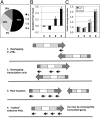Genome-wide landscape of polyadenylation in Arabidopsis provides evidence for extensive alternative polyadenylation
- PMID: 21746925
- PMCID: PMC3145732
- DOI: 10.1073/pnas.1019732108
Genome-wide landscape of polyadenylation in Arabidopsis provides evidence for extensive alternative polyadenylation
Abstract
Alternative polyadenylation (APA) has been shown to play an important role in gene expression regulation in animals and plants. However, the extent of sense and antisense APA at the genome level is not known. We developed a deep-sequencing protocol that queries the junctions of 3'UTR and poly(A) tails and confidently maps the poly(A) tags to the annotated genome. The results of this mapping show that 70% of Arabidopsis genes use more than one poly(A) site, excluding microheterogeneity. Analysis of the poly(A) tags reveal extensive APA in introns and coding sequences, results of which can significantly alter transcript sequences and their encoding proteins. Although the interplay of intron splicing and polyadenylation potentially defines poly(A) site uses in introns, the polyadenylation signals leading to the use of CDS protein-coding region poly(A) sites are distinct from the rest of the genome. Interestingly, a large number of poly(A) sites correspond to putative antisense transcripts that overlap with the promoter of the associated sense transcript, a mode previously demonstrated to regulate sense gene expression. Our results suggest that APA plays a far greater role in gene expression in plants than previously expected.
Conflict of interest statement
The authors declare no conflict of interest.
Figures




References
-
- Meyers BC, et al. Analysis of the transcriptional complexity of Arabidopsis thaliana by massively parallel signature sequencing. Nat Biotechnol. 2004;22:1006–1011. - PubMed
Publication types
MeSH terms
Substances
Grants and funding
LinkOut - more resources
Full Text Sources

